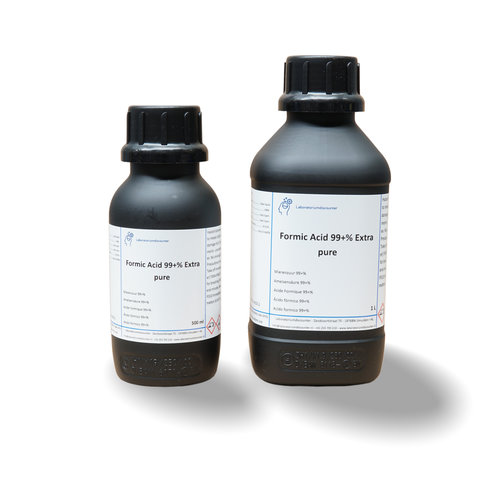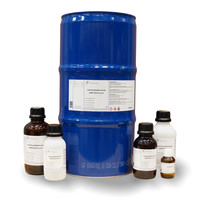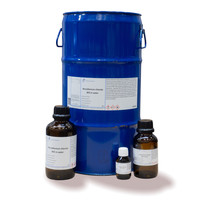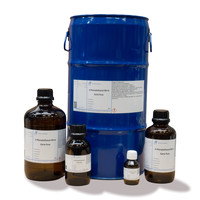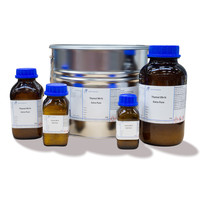You have no items in your shopping cart
Formic Acid 99+% Extra pure
- Buy 6 and save 5%
What is Formic Acid?
Methanoic acid (also called formic acid) is the simplest of the carboxylic acids. The chemical formula is CH2O2 or HCOOH. The conjugate base is the methanoate (formate) ion with the formula HCOO−. It is a weak acid that comes in the form of a colorless liquid with a pungent odor.
In nature, it is found in the glands of various insects of the order Hymenoptera, such as bees and ants, but also on the hairs that form the leaves of certain plants of the Urticaceae family (nettles). The trivial name ants comes from the Latin word formica, meaning ant, because it was first isolated by distillation of ants.
What is formic acid used for?
Methanoic acid is used in the following industries: textiles (dyes, leather treatment), insecticides, lacquers, solvents, tanning, electroplating and disinfectants. It is also used to silver mirrors.
It is also used in beekeeping as an additional agent to combat varroa mites (not permitted without a permit). It is also used in descalers (toilet gel).
-Biological tracer
During methanol poisoning, it is first metabolized to methanal by the action of alcohol dehydrogenase, a non-specific enzyme that has a better affinity for ethanol, and then to formic acid by the action of formaldehyde dehydrogenase. The last stage consists of the conversion to carbon dioxide, the limiting phase of elimination. Because methanal is rapidly metabolized, formate builds up and is the cause of toxicity (metabolic acidosis). Measurement of formates in urine can detect methanol poisoning.
-Hydrogen storage
Research from the Leibniz Institute for Catalysis in Rostock has shown that it could be used to store dihydrogen to power a fuel cell.
In the presence of platinum it is possible to decompose formic acid into dihydrogen and carbon dioxide.
CH2O2 → H2 + CO2
In 2006, a research team from EPFL (Switzerland) presented the use of formic acid as a hydrogen storage solution. A homogeneous catalytic system, based on an aqueous solution of ruthenium catalysts, decomposes formic acid HCOOH into dihydrogen H2 and carbon dioxide CO2. Dihydrogen can thus be produced in a wide pressure range (1 – 600 bar) and the reaction does not generate carbon monoxide. This catalytic system solves the problems of existing catalysts for the degradation of formic acid (low stability, limited catalyst life, formation of carbon monoxide) and makes this method of hydrogen storage viable. The by-product of this decomposition, carbon dioxide, can be used in a second step to generate formic acid again through hydrogenation. The catalytic hydrogenation of CO2 has been extensively studied and effective methods have been developed.
Formic acid contains 53 g of l-1 hydrogen at room temperature and pressure, which is twice the capacity of compressed hydrogen at 350 bar. Pure formic acid is a flammable liquid with a flash point of +69°C, which is higher than petrol (-40°C) or ethanol (+13°C). Diluted from 85% it is no longer flammable.
buy formic acid?
Are you looking for formic acid with a concentration higher than 99%? Then you have come to the right place at Laboratorydiscounter! Not only is this formic acid at least 99% pure, but also low in impurities and extra low priced.
How do I work safely with formic acid?
Formic acid is a flammable and corrosive vaporous liquid, so it is important to be well prepared and to use the correct BPMs. Because it vaporizes, it is recommended to use it outside and to always wear a gas mask. Because it is also corrosive, it is also necessary to wear protective clothing, gloves and safety glasses. Formic acid can react with many metals which can cause corrosion. Always read the safety data sheet before use.
Store formic acid safely
Formic acid is an unstable substance, which means that it decomposes on its own. One of the products of this decomposition is carbon monoxide which is a gas. It is therefore important that formic acid is stored in the packaging supplied with a vent cap. If this is stored in a different container with a different cap, there is a chance that pressure will build up, causing the bottle to burst, which can cause extremely dangerous situations.
Technical data
Formylic acid, Methanoic acid, Hydrogen carboxylic acid
Empirical formula CH2O2
Molar mass (M) 46,02 g/mol
Density (D) 1,22 g/cm³
Boiling point (bp) 101 °C
Flash point (flp) 49 °C
Melting point (mp) 4 °C
ADR 8 II
WGK 1
CAS No. 64-18-6
EG-Nr. 200-579-1
UN-Nr. 1779
$$$$$
Hazard statements
H226 Flammable liquid and vapour
H290 May be corrosive to metals
H302 Harmful if swallowed
H314 Causes severe skin burns and eye damage
H331 Toxic if inhaled
Precautionary statements - prevention
P210 Keep away from heat, sparks, open flames, hot surfaces. No smoking
P280 Wear protective gloves/eye protection/face protection
Precautionary statements - response
P303+P361+P353 IF ON SKIN (or hair): Take off immediately all contaminated clothing. Rinse skin
with water [or shower]
P304+P340 IF INHALED: Remove person to fresh air and keep comfortable for breathing
P305+P351+P338 IF IN EYES: Rinse cautiously with water for several minutes. Remove contact
lenses, if present and easy to do. Continue rinsing
P310 Immediately call a POISON CENTER/doctor
Supplemental hazard information
EUH071 Corrosive to the respiratory tract.




